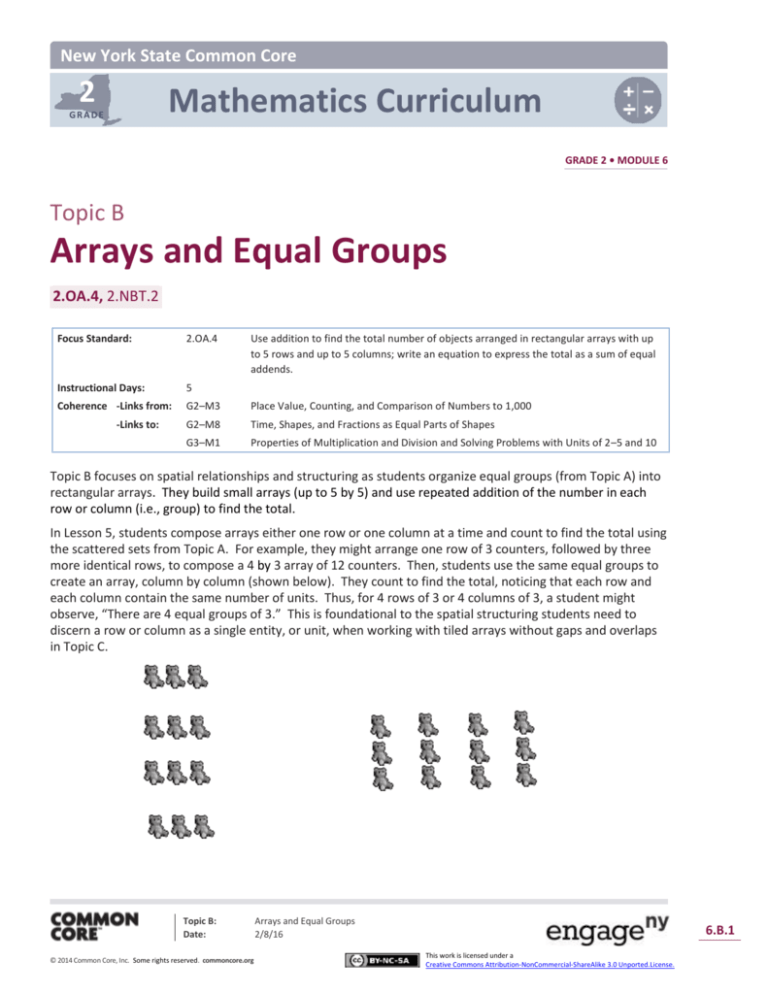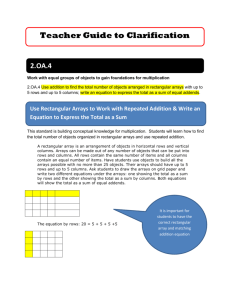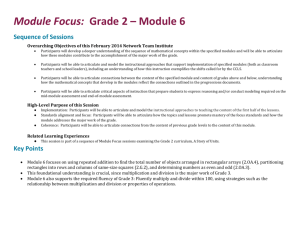
New York State Common Core
2
Mathematics Curriculum
GRADE
GRADE 2 • MODULE 6
Topic B
Arrays and Equal Groups
2.OA.4, 2.NBT.2
Focus Standard:
2.OA.4
Instructional Days:
5
Coherence -Links from:
G2–M3
Place Value, Counting, and Comparison of Numbers to 1,000
G2–M8
Time, Shapes, and Fractions as Equal Parts of Shapes
G3–M1
Properties of Multiplication and Division and Solving Problems with Units of 2–5 and 10
-Links to:
Use addition to find the total number of objects arranged in rectangular arrays with up
to 5 rows and up to 5 columns; write an equation to express the total as a sum of equal
addends.
Topic B focuses on spatial relationships and structuring as students organize equal groups (from Topic A) into
rectangular arrays. They build small arrays (up to 5 by 5) and use repeated addition of the number in each
row or column (i.e., group) to find the total.
In Lesson 5, students compose arrays either one row or one column at a time and count to find the total using
the scattered sets from Topic A. For example, they might arrange one row of 3 counters, followed by three
more identical rows, to compose a 4 by 3 array of 12 counters. Then, students use the same equal groups to
create an array, column by column (shown below). They count to find the total, noticing that each row and
each column contain the same number of units. Thus, for 4 rows of 3 or 4 columns of 3, a student might
observe, “There are 4 equal groups of 3.” This is foundational to the spatial structuring students need to
discern a row or column as a single entity, or unit, when working with tiled arrays without gaps and overlaps
in Topic C.
Topic B:
Date:
© 2014 Common Core, Inc. Some rights reserved. commoncore.org
Arrays and Equal Groups
2/8/16
6.B.1
This work is licensed under a
Creative Commons Attribution-NonCommercial-ShareAlike 3.0 Unported.License.
Topic B 2 6
NYS COMMON CORE MATHEMATICS CURRICULUM
In Lesson 6, students decompose one array by both rows and columns. Thus, an array of 4 rows of 3 teddy
bears can be pulled apart to show either 4 rows of 3 or 3 columns of 4. Also, students see that when another
row or column is added or removed, so is another group, or unit. As Lesson 6 progresses, students move the
objects of the arrays closer together so the gaps are smaller, forcing them to discern the rows and columns
without the visual aid of spacing. For example, when decomposing a 4 by 3 array, students see the rows as
equal groups of 3. After identifying the number in each row, or group, students realize that they can write a
repeated addition sentence to find the total number of objects in the array: 3 + 3 + 3 + 3 = 12. It may be
noted that since there are 4 rows, the equation will have 4 addends, or 4 threes. Students add from left to
right and write the sum, such that 3 plus 3 equals 6, 6 plus 3 equals 9, and 9 plus 3 equals 12.
In Lesson 7, students move to the pictorial as they use math drawings to represent arrays and relate the
drawings to repeated addition. For example, students are asked to draw an array with 4 rows of 3 or 3 rows
of 4 on their personal white board, and then use their marker to draw horizontal lines to see the rows within
the array (shown below). When counting rows containing 3 or 4 objects, students apply repeated addition
strategies once again, adding from left to right to find the sum (e.g., 4 + 4 + 4 = 12, such that 4 plus 4 equals 8
and 8 plus 4 equals 12). Additionally, when representing arrays with rows of 2 or 5, students may add to find
the total and naturally point out a connection to skip-counting by twos or fives (2.NBT.2); the focus, however,
is on establishing a strong connection between the array and repeated addition.
3
4
3
4
3
4
3
3 + 3 + 3 + 3 = 12
4 + 4 + 4 = 12
In Lesson 8, students work with square tiles to create arrays with gaps, composing the arrays from parts to
whole, either one row or one column at a time. Seeing arrays as composed of individual, separated tiles
provides the foundation for Topic C, where students work with square tiles without gaps. As usual, students
relate the arrays to repeated addition.
In Lesson 9, students apply the work of Topic B to word problems involving repeated addition (shown below),
interpreting array situations as either rows or columns and using the RDW process, e.g., “Mrs. Levy moves
desks into 3 columns of 4 desks. How many desks does she move?” In addition to drawing objects, students
may also represent the situation with more abstract tape diagrams, just as they did in the final lesson of
Topic A.
Topic B:
Date:
© 2014 Common Core, Inc. Some rights reserved. commoncore.org
Arrays and Equal Groups
2/8/16
6.B.2
This work is licensed under a
Creative Commons Attribution-NonCommercial-ShareAlike 3.0 Unported.License.
Topic B 2 6
NYS COMMON CORE MATHEMATICS CURRICULUM
A Teaching Sequence Toward Mastery of Arrays and Equal Groups
Objective 1: Compose arrays from rows and columns, and count to find the total using objects.
(Lesson 5)
Objective 2: Decompose arrays into rows and columns, and relate to repeated addition.
(Lesson 6)
Objective 3: Represent arrays and distinguish rows and columns using math drawings.
(Lesson 7)
Objective 4: Create arrays using square tiles with gaps.
(Lesson 8)
Objective 5: Solve word problems involving addition of equal groups in rows and columns.
(Lesson 9)
Topic B:
Date:
© 2014 Common Core, Inc. Some rights reserved. commoncore.org
Arrays and Equal Groups
2/8/16
6.B.3
This work is licensed under a
Creative Commons Attribution-NonCommercial-ShareAlike 3.0 Unported.License.








